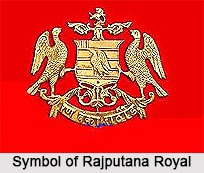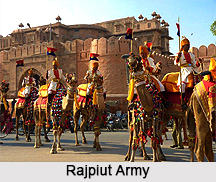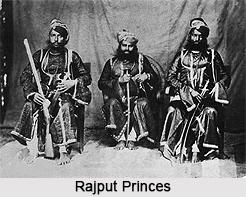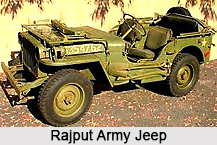 Rajputs are one of the major Hindu Kshatriya groups in India. After the death of Harsha, northern India disintegrated completely. This period was marked by the ascendancy of the Kshatriya clan, Rajputs.
Rajputs are one of the major Hindu Kshatriya groups in India. After the death of Harsha, northern India disintegrated completely. This period was marked by the ascendancy of the Kshatriya clan, Rajputs.
Under their rule several small kingdoms sprang up. These small provincial kingdoms, however, were continuously at war with each other. This period has been conveniently termed as the Rajput period by the historians. Though the origin of the Rajputs had not yet been discovered, the historians have opined that there were several dynasties belonging to the Rajput house proper.
Rule of Rajputs
The main feature of the Rajput kings was that they were reckoned as warriors and as influential rulers. They played a significant part in materialising the modern-day society in northern India. Apart from this they showered patronage on art and architecture and the Rajput rulers were also prolific builders of beautiful palaces. As per the archaeological evidence and contemporary texts, the Indian society had achieved significant prosperity during the Rajput rule. During their ruling period in India the spread of literacy attained great heights. Indian literature had reached to its zenith during this period and the literature in Sanskrit and in Apabhramshas which constitutes a large segment of the classical Indian literature.  Rajputs allowed intermarriage among the different Rajput clans that interlinked different regions of India and this made the trade and scholarship easier to flow from one part of the country to another. Though the majority of Rajputs practice Hinduism but they also practiced Shaivism, Vaishnavism, Shaktism and occasionally Jainism as well. They had strong support for Buddhists, Zoroastrians and Sufi traditions including Sikh panth as well.
Rajputs allowed intermarriage among the different Rajput clans that interlinked different regions of India and this made the trade and scholarship easier to flow from one part of the country to another. Though the majority of Rajputs practice Hinduism but they also practiced Shaivism, Vaishnavism, Shaktism and occasionally Jainism as well. They had strong support for Buddhists, Zoroastrians and Sufi traditions including Sikh panth as well.
Rule of Pratiharas and the Chauhans
The Pratiharas and the Chauhans rose in ascendancy in the Rajput Period. The Rajputs were the warrior clan and during this period they captured the whole of northern India under their supremacy. The victory in the Tripartite Struggle established the suzerainty of the Pratiharas in northern India. However, the Pratihara supremacy declined under the successors of Mahipala Pratihara. The Rajput power again revived under Prithviraj Chauhan.
Etymology of Rajputs
Vedic literature mentions that Rajput is derivative of the concept of the word `Rajaputra` meaning the "Son of a King". According to the then social structure the Rajputs were the assimilation of 36 "royal races," or `raj kuls`. They were considered to be migrants to India from Central Asia who mingled with the aboriginal tribes and were given Kshatriya or warrior status by the priests. Even the Huns were also commonly listed as one of the `raj kuls`.
Among the different Rajput tribes there are Suryavanshi Rajputs, Chandravanshi or Yaduvanshi Rajputs that deserve special mention. Apart from these there are the Agni-kuls. According to the evidences, the generally acknowledged Agnikuls are the Chauhans, Parmars, Chalukyas, and the Purihars.
 Concentration of Rajput
Concentration of Rajput
Rajputs are a community that hailed basically from northern India and Gujarat. The main centres of the Rajputs were Rajasthan, Uttar Pradesh and Madhya Pradesh but their clans have had a long and significant presence in other states. In Madhya Pradesh Rajputs are the major Hindu caste and their dominance exists in Bihar, Uttarakhand, Himachal Pradesh and Gujarat as well. Rajputs of India encompass many different tribes and they were praised for their valour and chivalry in battle.
Social Hierarchy of Rajputs
Rajputs maintained a strong social hierarchy and the Brahmins received good support from them. Rajputs also patronised art and culture. The Rajput chiefs ruled much of northern and western India from 7th to 12th centuries until they were subdued by Muslim invaders in 1200 AD. During this time, many Hindu Rajputs were employed in the Mughal army. Even the Rajputs also joined the sepoy forces of the East India Company as infantry and cavalry from an early period. Prior to the Indian Mutiny of 1857, the Rajputs and Brahmins from Bihar and Oudh became the principal recruits sought by the Bengal army and also by Bombay army.
Culture of Rajputs
Rajputs followed a traditional life style which was also the representation of martial spirit. They celebrate the festival of Rakhi and as per the belief of the Rajputs the bracelets would avert evil in battle. The dressing style and tradition of the Rajputs also carry their chivalric grandeur and ethnicity. As leaders of a primarily feudal society, they played the role of protectors. Affluent and powerful, they wear garments made of fine fabric, with elaborate designs and a high degree of ornamentation. The Rajput men, who were essentially warriors and farmers, always present a distinctly masculine appearance. The rajput men wear aristocratic dresses that are quite elaborate Court-dress and consists of pagadi, angarkhi, churidar pyjama and a belt called the cummerbund. The angarkhi is a long upper garment, worn over a sleeveless close fitting vest. It has an asymmetrical front with a yoke and is open, down its length at the centre-front and is fastened with cloth ties at the shoulder and at the centre-front waist. Other upper garments worn by royalty include the `jama` and the `shervani`. Lower garments include the `salvar`, a pair of shaped-trousers and the `churidar-pyjama`, which is a fitted pair of trousers.  The dhoti is also worn, though styles differ from region to region. The tevata style is most commonly worn in the Thar Desert region, while the other regions use the tilangi style. An interesting variation used by some older men is a semi-structured dhoti in which both the edges are stitched together. The Jodhpur-coat worn with Jodhpurs is a popular and typical combination worn by the Rajput men.
The dhoti is also worn, though styles differ from region to region. The tevata style is most commonly worn in the Thar Desert region, while the other regions use the tilangi style. An interesting variation used by some older men is a semi-structured dhoti in which both the edges are stitched together. The Jodhpur-coat worn with Jodhpurs is a popular and typical combination worn by the Rajput men.
Costumes of Rajputs
The costumes of the young Rajput girls include an upper garment called `puthia` which is made up of cotton fabric in colours of yellow, pink and white and may be either plain or printed. The young girls wear a loose pyjama called `sulhanki`. The married women wear `kanchli`, `angia` and `kurti` as upper garments that are made of satin or fine cotton in red, magenta, green or yellow. The `kanchli` is heavily ornamented with gota in floral designs. The `kurti` is a short sleeveless tunic with a deep neckline, which is worn over the `kanchli` and reaches a little below the waist. The women wear `angia` at the time of marriage and the fabric and design of the `angia` is almost the same as for the `kanchli`. Widows and unmarried women of the Rajput community wear `polka`, which is a half-sleeved bodice that ends at the waist. Moreover the `ghaghra` of the Rajput woman is a voluminous gored skirt of line satin, silk or organza. The `ghaghras` are decked with gold or silver embroidery that display the affluence of the wearer. Rajput women wear three styles of `ghaghra` namely Kalidar, `charpaui` and `kalipatti`. One of the most important parts of the women costume is the `odhna` which is woven in brocade and is worked in silk thread on a bright base, like pink or violet. The Rajput women wear different types of `odhnas` depending on different occasions. The Rajput women prefer to wear jewelleries and these jewelleries are exquisite in style and design. Rakhdi is a head ornament; `machi-suliya` is worn on the ears. Their necklaces are the `tevata`, the `pattia` and the `aad`. The `rakhdi`, `nath` and the `chuda` are symbolic of a woman`s married status. Ornaments for the feet include the `jod`, `rimjhol` and the `pagpan`. The footwear of both men and women are very similar called `juti` and is made of leather with dense embroider on the surface. The Rajputs are the groups that carry a distinct style in their traditional costumes. The men and women of this community prefer to embellish themselves with various jewelleries and ornaments.






